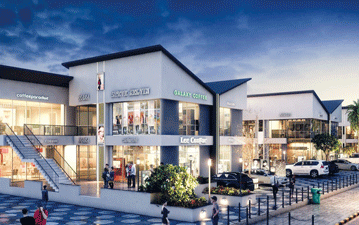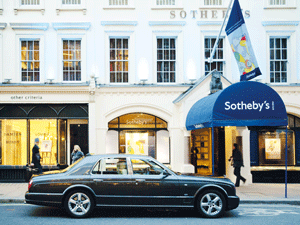ARTWORK : Goa’s traditional villas set in tranquil villages like Aldona and Saligao are now being sought by Sotheby’s, biggest art auction house which thinks Goa is a premium resort for international buyers.
By Rajan Narayan
Goa is being converted into a coal hub by industrialist Gautam Adani in collusion with Minister of Transport Nitin Gadkari. Goa is being turned into an annexe of Bollywood with the stars of tinsel town buying Portuguese villas. This has driven up land values to the extent that few Goans can now buy even a 1BHK flat, let alone a villa. Goans do not want development at the expense of Goa’s unique, cosmopolitan identity!
When I came to Goa in 1983 it was still a green serene village. Admittedly unlike in other parts of the country, Goan villages were more urbanized. This was particularly true of the coastal villages which had started attracting tourists. I am inclined to believe that it was the Commonwealth heads of Government Retreat (Chogm) which put Goa on the international tourism map. The world discovered Goa and charters from Germany and the UK started arriving in increasingly large numbers. This was followed by charters from Russia and other parts of the Soviet union like Khazakistan and Ukraine. The coming of the charters led to the shacks sprawling all over the beaches. This was because while according to the terms of the charter, the foreign tourists had to spend three weeks in a starred hotel, many of them could not afford to have all their meals in the hotel. The chartered tourists from the UK were really the lower end comprising of bartenders and waitresses. They would pack some food from the breakfast buffet which was compulsory and spend the entire day on the beach with the shacks catering to them. Part of the reason why foreign chartered tourists were able to integrate with the locals was that the hippies had already introduced locals to sunbathing on the beaches and even nudity. But chartered tourism unlike the recent waves of domestic tourists did not create hostility between Goans and the outsiders. This was because the chartered tourists were used to beach protocols and would consider it very horrific to leave broken beer bottles on the beaches.
migration
In the 80’s, Goa was still a green cosmopolitan oasis in a country which was increasingly getting polarized. There was migration from the neighboring states. However these migrants came to Goa primarily to look for jobs. They found it easy to get jobs as they were only interested in jobs that Goans would not consider doing in their own state. Primarily the migrant labor were involved in manual jobs. Unlike Goans who would not consider sweeping the floor and cleaning the toilets, the migrants were willing to do any kind of job. This was because with increasing mechanization there were fewer jobs in the rural areas. Migrants found Goa very attractive because the minimum wages are much higher than back home. Indeed even today any migrant can come to Goa and get a job as a security guard or a shop assistant for an average of Rs. 10,000/-. If their wives accompany them, they get themselves employed as male servants supplementing the income of the migrant family. The early migrants who came to Goa in the first three decades after migration never went back. They became “Bhumiputras” and integrated with the local population. Many of them speak better Konkani than persons of Goan origin (POGOS). This is relevant as in the current election we had a Goa Revolution party that wanted to replace all the migrants with POGOS. Never mind that the POGOS who get ten pounds per hour to sweep the Heathrow airport or work as a shop assistant in the UK who would never consider returning to Goa.
Last week when I was having dinner with an acquaintance, she insisted that Goans were racist and casteist. This came as a shock to me as in my experience I have never encountered any prejudice. Admittedly the Goans are not the gregarious caricatures that the tourist brochures project Goa as. Goans are not necessarily friendly or very hospitable to outsiders excepting if it is for business reasons. But this is true of every state in the country. You will not find people in Maharashtra or in Karnataka or in Uttar Pradesh inviting strangers to their house. The reality is that Goans are insular. They are proud of their own identity. Nobody complains about Marathas or Jets of Punjab being proud of their distinct identity. Similarly, Goans also want to retain their privacy. How Goans react to outsiders is to a large extent determined by how much effort the outsiders take to integrate with Goans and Goan causes.

The conflict or clash of interest has really started over the last two decades and intensified over the last decade. Goans have no problems with lower-class migrants who are willing to help them by accepting jobs on the trawlers. They have problems with migrant drivers who will drive the cars they bought from their earnings in the gulf. They eagerly wait for the migrants to return in time for the tourism season as most of the employees of shacks are migrants. The majority of the Chinese cooks in Goan Hotels are really from Nepal. Since the casinos started a huge labor market has opened for people from the North-East. Goan parents don’t want their children to work in the casinos and the feeling is mutual. The casino owners don’t want Goans. The basic area of conflict is between the upper-middle class and the bold and the beautiful and the rich and the powerful who have bought second holiday homes. The conflict is between those who have relocated in Goa from New Delhi and Mumbai. This is primarily because Goa is much pleasanter as a retirement destination. Moreover, property in Goa is much cheaper than in Mumbai. What you can purchase for 1 foot in Mumbai will fetch you 1 meter in Goa. Many of these people who have relocated in Goa are victims of the tourist propaganda that Goans are warm welcoming people who love their neighbors as themselves. I recall the comic sample of a rich elderly couple from Mumbai who bought a fancy villa in Altinho. The lady even went to the extent of getting a chef to bake cakes for all her neighbors. In the expectation that her gesture would be reciprocated and that the couple would be invited for Christmas. If they had bothered to make some enquiries, they would have learned that Christmas lunch is a private family affair and even close friends are not invited. The worst part is the rich and the powerful who buy duple flats costing 5 crores or more in Dona Paula expect the same kind of amenities that they were used to in Mumbai. I have come across senior citizens who relocated to Goa searching for bridge partners. Or wanting to know where the golf course is. Goa has only one golf course which is controlled by the Navy and does not provide access to even locals. The only other golf course is in a seven star luxury hotel which will cost an arm and a leg.
The majority of the upper crust who relocate in Goa do not care to integrate with the local population. They do not care to get involved in causes which will damage the very Goa they fell in love with. We have not seen any outsiders worried about Gautam Adani converting Goa into a coal hub. Or protesting against the double-tracking of the South-Western railway line from Vasco to Karnataka. Or the broadening of the highways. Not for the benefit of the locals including those who relocated in Goa. But for the benefit of the Adanis and the other industries located in Karnataka who want to convert the Momurgao Port Trust (MPT) into a dirty cargo port. We have seen very few Goans who were part of the Goa Bachao Abhiyan which was the protest against the concretization of Goa. If Panaji particularly the Miramar bypass road and Dona Paula have become concrete jungles, it is thanks to the demand for up-market villas and flats for outsiders. If the Kadamba plateau is giving way to a huge commercial and residential complex, it is due to the demand from the bold and the beautiful and the rich and the powerful Mumbai-Indian.
Thanks and no thanks. Goans are not interested in becoming a Singapore or a Hawaii. Goans are not interested in becoming an up-market tourist destination. With Eiffel towers on their bridges as proposed to the case of the new Zuari bridge. Goans want to retain the original character of Goa. It’s original character as largely a rural green agricultural state. They are anxious to protect the Divar Island from being taken over. The Jacintha Island has already been taken over MPT. Goans do not want small little pretty islands like Vanshi which has been sold by the church to a Bangalore builder to build a Marina. Which is why Goans are so concerned about the Nationalization of the rivers by the Modi government which will enable Adani to set up jetty’s for the transport of coal. Goans are not very enthused by the sky being filled with hot air balloons and drones. Or helipads so that Narendra Modi can travel from the airport to the ground outside the Bodgeshwar temple Mapusa for a public meeting.
The Modi government King size. For the Modi government bridges and flyovers are symbols of growth. To the extent that the Modi government built the Purvanchal expressway in Uttar Pradesh which was broad enough and strong enough to enable the Prime Minister to land the biggest Naval transport plane. Nitin Gadkari’s claim to fame is that he built twenty-two flyovers in Mumbai. That he built the Mumbai-Pune eight lane expressway which cut short the travelling time to four hours. Mercifully the Goa bench of the Bombay High Court struck down his proposal for building an expressway between Goa and Mumbai. The court told Gadkari to repair the potholes on the highways first.
DEVELOPMENT
Goans believe in sustainable development. They do not want Goa to become a urban industrialized over-crowded noisy congested hell – like Bangalore. Till the sixties, Bangalore was the original pensioner’s paradise. Even though there were a lot of engineering colleges, those passing out were happy to work in the public sector mega companies like the Indian telephone industries and Hindustan aeronautics. Even if one of them got a job in a multinational in Mumbai or Gurgaon they would reject it as they would not want to live in dirty overcrowded cities. Now the city of gardens has become the country’s biggest IT hub. Where it takes four hours to travel to the airport to the Leela hotel which is only ten kilometers away. Which is already happening in Goa where it takes more than two hours to travel from Panaji to Margao. Please leave us in Peace. We are not interested in more migrants, particularly upper-class migrants. The labor migrants do not want Villas. They do not want swimming pools. They do not want fleets of cars. They are not a burden on the infrastructure. We do not have enough water. We do not have enough power. All our power comes from outside the state. We have very poor internet connectivity. Our population has already crossed 15 lakhs. We do not want to chew more than we can swallow. Literally because Goa has the largest number of fancy restaurants per capita in the country.
